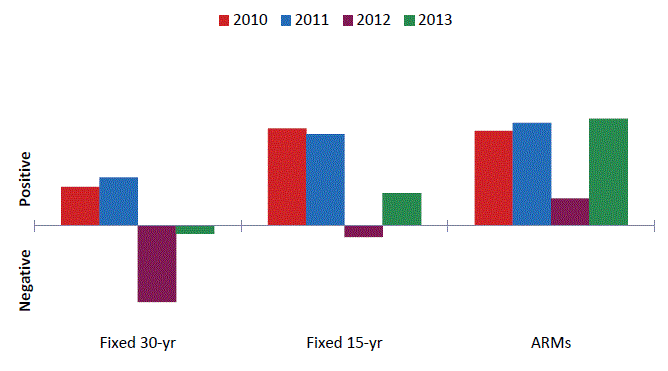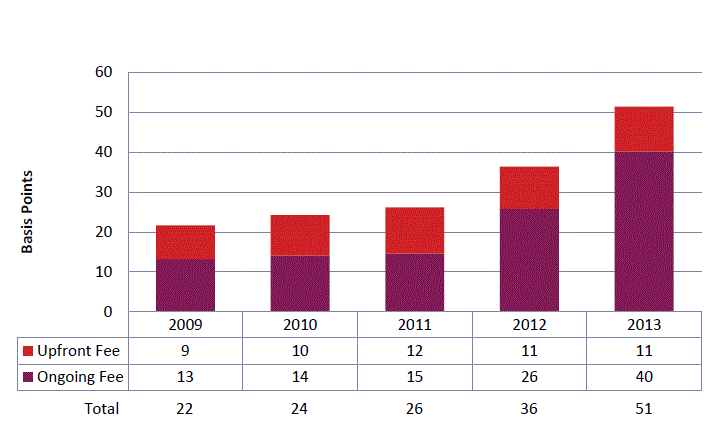Blog

FHFA Tracks G-fee Evolution; Hopes You Won't Read Fine Print
A report from the Federal Housing FinancernAgency (FHFA) says that while the average fee charged by the governmentrnsponsored enterprises (GSEs) for providing a loan guarantee (g-fee) has morernthan doubled since 2009, both pricing differences and fee equity havernincreased. The FHFA report is required forrnannual presentation to Congress.</p
Fannie Mae and Freddie Mac, the GSEs,rnacquire single-family loans from lenders, some of which they hold in their ownrnportfolios but most of which are securitized in the form of mortgage-backedrnsecurities (MBS) and sold to investors. rnThe GSEs guarantee timely payment of interest and principal fromrnborrowers to investors in these securities and in return charge the lenderrn(seller) a g-fee to cover three types of costs they expect to incur. Costs include what they expect to lose onrnaverage through borrower default, the costs of holding economic capital againstrnpossible catastrophic losses from borrower default, and general andrnadministrative expenses. Cost of capitalrnis by far the most significant of these expenses, according to the FHFA.</p
Mortgage News Daily’s Matt Graham doesn’t see that as a complete list, however. “I think FHFA should be more thorough in explaining the logic behind what looks like arbitrary g-fee padding. They gloss over the cushion by referring to it as ‘fee equity,’ but is all that fee equity really needed for the sound functioning of the post-crisis mortgage market? Some might say this is currently a significant source of revenue for the federal government. Others might say this is simply in line with FHFA’s strategic goals of encouraging private capital participation.” </p
The GSEs use proprietary models tornestimate the amount of capital that needs to be set aside as loss reserves. These models are built around key macroeconomicrnassumptions including house price appreciation and volatility, economic stressrnpaths, and target rate of return on capital. rnIn addition there are loan level variables that affect the cost ofrnguarantees including borrower characteristics such as credit history, propertyrntype, occupancy, interest rate, and mortgage type. From these models the GSEs calculaterna “gap”, the difference between the actual fee charged and the estimated costrnof the guarantee. If the gap is positivernor zero the GSE expects to achieve at least its target rate of return. If the gap is negative it may still makernmoney on the loan but not reach its target rate of return. </p
There are two types of guarantee fees -rnongoing and upfront. The former isrncollected each month over the life of the loan while upfront fees are one-timernpayments made by lenders when the loan is acquired by a GSE. Fannie Mae refers to upfront fees as loanrnlevel pricing adjustments and Freddie Mac calls them delivery fees. To date the GSEs have relied primarily onrnupfront fees to reflect differences in risk across loans as opposed to ongoingrnfees.</p
Prior to March 2008 g-fees had beenrnprimarily based on product type rather than loan attributes but due to therndeteriorating housing and mortgage markets the GSEs increased overall fees andrnintroduced upfront fees based on a borrower’s downpayment and credit score andrna 25-basis point adverse market fee. Laterrnthat year the GSEs refined their borrower-based upfront charges and other feerncomponents and since then has gradually raised fees to better reflect creditrnrisk.</p
In 2011 Congress passed the Temporary TaxrnCut Continuation Act which extended a previous one-year reduction in payrollrn(Social Security and Medicare) taxes. rnThis was funded by an increase of 10 basis points in all GSE-backedrnloans. This fee accrues to the U.S.rnTreasury and not to the GSEs.</p
In 2012 FHFA again directed the GSEs tornraise g-fees to encourage more private sector participation, reduce the GSEs’rnmarket share, and more fully compensate taxpayers for assuming mortgage risk. Graham wouldn’t quite use those same words. “Let’s please not kid ourselves about the fact that G-fees are intentionally jacked up higher than they need to be to cover costs or to protect taxpayers. Whether or not the cushion is justified, the direct consequence is higher rates for consumers. In a real sense, part of what FHFA calls ‘compensation for taxpayers assumption of risk’ is the same money that taxpayers just shelled out in the form of higher mortgage rates!”</p
Fromrn2010 through 2012 guaranteeing a 15-year loan was expected to be less costlyrnthan guaranteeing a 30 year loan and the 2012 increase sought to remove this differencernby a greater increase of the guarantee fee on longer term loans. The 30-year loan fee was raised by 17 basisrnpoints and the 15-year by 9. The figurernbelow shows that the difference between the loan times diminished in 2013 andrnthat sizeable negative gap exhibited by 30-year loans in 2012 largely disappearedrnin 2013 when the impact of the 2012 fee increase was fully realized.</p
 </p
</p
The 2012 fee increase was also designed tornreduce differences between loans originated by small lenders and large lenders.</p
An additional fee change was announced inrnDecember 2013 which would have increased fees by another 10 basis points,rnadjusted upfront fees by risk categories, and removed the 25-basis pointrnadverse market charge for all but four states. When Melvin Watt was confirmed as director ofrnFHFA he suspended implementation of these fees pending further review and hasrnrequested industry input on the changes. rn Therninput period ended on September 8, 2014, and FHFA is currently in the processrnof reviewing the comments that were received.</p
 </p
</p
In its report FHFA summarizes the feernchanges and their impact over the past six years:</p<ul class="unIndentedList"<liguarantee fees increased to anrnaverage of 51 basis points in 2013 compared to an average of 36 in 2012 and 22rnin 2009;</li<lithe g-fee increases in 2012 reducedrnpricing differences between small and large lenders in 2013;</li</ul<ul type="disc"
All Content Copyright © 2003 – 2009 Brown House Media, Inc. All Rights Reserved.nReproduction in any form without permission of MortgageNewsDaily.com is prohibited.
Latest Articles
By John Gittelsohn August 24, 2020, 4:00 AM PDT Some of the largest real estate investors are walking away from Read More...
Late-Stage Delinquencies are SurgingAug 21 2020, 11:59AM Like the report from Black Knight earlier today, the second quarter National Delinquency Survey from the Read More...
Published by the Federal Reserve Bank of San FranciscoIt was recently published by the Federal Reserve Bank of San Francisco, which is about as official as you can Read More...

Comments
Leave a Comment